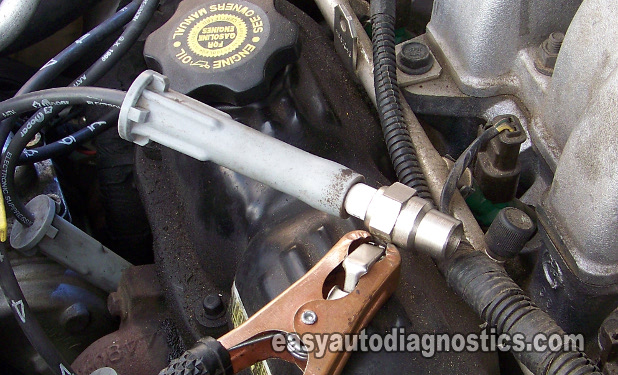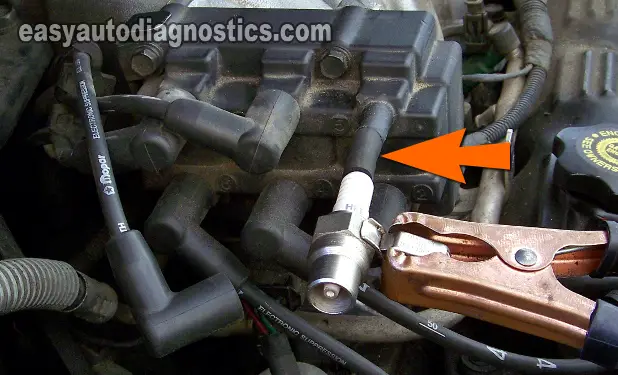TEST 1: Testing For Spark At The Spark Plug Wire
Whether you know which cylinder is the one misfiring, because you have retrieved specific misfire codes (like: P0301, P0302, P0303, P0304, P0305, P0306), or you don't know, this is where you need to start your diagnostic and/or troubleshooting.
The following test steps assume that you're gonna' test all cylinders for spark by starting with #1 cylinder.
Do you have to test them all? The answer is NO, you don't have to test them all (especially since the 3 spark plug wires that face the firewall are a complete pain in the neck to test).
You can test the cylinders you want or have misfire codes for. Remember, the successful outcome of your trouble-shooting/diagnostic lies in the usage of an HEI spark tester.
If you don't have an HEI spark tester and need to buy one, you can buy it here: OTC 6589 Electronic Ignition Spark Tester.
Let's get this show on the road:
- 1
Remove the spark plug wire (high tension cable) from the spark plug.
- 2
Attach the spark tester to the spark plug wire.
- 3
Connect the spark tester to the battery negative (-) terminal with a battery jump start cable as shown in the photo in the image viewer.
- 4
Have your helper crank the engine while observing the spark tester from a safe distance.
CAUTION: The vehicle may or may start, either way be careful. - 5
You're gonna' get one of two results:
1.) Spark.
2.) No spark. - 6
Repeat this test on the rest of the cylinders (if needed or applicable).
IMPORTANT: If you get a no-spark result from two or more cylinders, you're gonna' need to check if those spark plug wires connect to paired cylinders. Just to refresh your memory, paired cylinders would be:
- Cylinders #1 and #4.
- Cylinders #2 and #5.
- Cylinders #3 and #6.
Examples of unpaired cylinders would be: cylinders 1 and 3, or 2 and 4, or 1 and 2, etc.
Alright, let's interpret your test results:
CASE 1: You got spark from all 6 spark plug wires. This indicates that the ignition coils and spark plug wires are OK. The cause of your misfire condition is not due to a bad ignition coil.
Your next step is to go to: TEST 8: Other Possible Misfire Causes to see further tips and suggestions.
CASE 2: You got NO spark from only one spark plug wire. The next step is to check for spark directly on the coil pack tower that feeds that spark plug wire with spark. Go to: TEST 2: Testing For Spark At The Ignition Coil Pack.
CASE 3: You got NO spark from two spark plug wires that connect to paired cylinders 1 and 4 or paired cylinders 2 and 5 or cylinders 3 and 6. The next step is check for spark directly on the ignition coil towers (one at a time of course) that feed those spark plug wires.
For this test, go to: TEST 3: Testing For Spark At The Ignition Coil Pack.
CASE 4: You got NO spark from two spark plug wires that DO NOT connect to paired cylinders. The next step is to test each coil pack tower directly for spark one at a time. Go to: TEST 2: Testing For Spark At The Ignition Coil Pack.
CASE 5: You got NO spark from none of the spark plug wires. This usually indicates that power is missing from the power circuit or that the crankshaft position sensor is bad.
Your next step is to go to: TEST 4: Testing The Power (12 Volts) Circuit.
TEST 2: Testing For Spark At The Ignition Coil Pack
In this test step, you're gonna' test for spark directly on the ignition coil pack tower that connects to the spark plug wire that did not spark in TEST 1.
If you get spark, then you can conclude that the spark plug cable that did not spark (in TEST 1) is defective and all of the spark plug wires should be replaced as a set.
If you don't get spark, then the ignition coil pack is defective and needs to be replaced.
These are the test steps:
- 1
Remove the spark plug wire that did not fire off spark from the ignition coil pack.
- 2
Place the spark tester directly on the ignition coil tower using a small piece of vacuum hose.
IMPORTANT: It is crucial that you use this piece of vacuum hose! (see photos in the image viewer). - 3
Connect the spark tester to the battery negative (-) terminal with a jump start cable (see photo).
- 4
Have your helper crank the engine.
CAUTION: The engine may start, so be careful. - 5
You're gonna' get one of two results:
1.) Spark.
2.) No spark.
Let's see what your test results mean:
CASE 1: You got spark. This result lets you know that the ignition coil is good and that the spark plug wire is bad. Replace all of the spark plug wires as a set.
CASE 2: You got NO spark. This test result confirms that the ignition coil is bad.
Replacing the ignition coil will solve the misfire condition and the misfire code lighting up the check engine light (CEL) on the instrument cluster.



